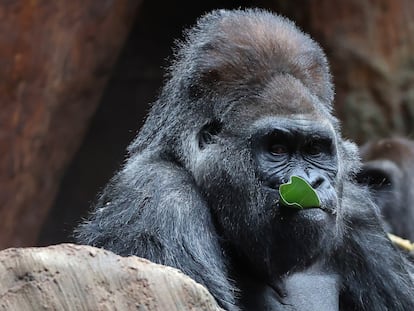Researchers successfully test one-time injection to permanently spay female cats
A U.S. project sterilized six felines over four years. The single dose opens an alternative route to surgery

Veterinarians recommend neutering cats, both to be able to live with them (a female cat “in heat” can be very annoying), and to prevent them from suffering any pathologies that could arise from not reproducing. It is also the plan provided for in the Spanish animal welfare law, which speaks of the TNR method (trap-neuter-return), to control cat colonies and prevent them from becoming overcrowded. This Tuesday, the journal Nature Communications published an article with the first results of an injection developed in the United States to sterilize female cats. Researchers have used a virus to introduce a hormone, called antiMüllerian hormone (AMH), into the body of these animals to inhibit ovulation and prevent gestation.
The study was carried out with nine female cats, with six treated and three as a control group. The initial data shows the efficacy of this method and opens an alternative route to surgery. None of the treated cats became pregnant and no side effects were observed four years after the test. This came as no surprise to the researchers, as the study’s lead author, William Swansson, explains: “This is a natural protein, which is already produced by females. The concentration of the hormone at higher than normal levels slows down ovulation.”
A possible protective effect against pathologies such as cystic endometrial hyperplasia (an alteration of the endometrium) and pyometra (an infection of the womb) has even been observed. Swansson, of the Cincinnati Zoo and Botanical Garden, attributes this to the suppression of ovulation and the subsequent lower production of progesterone, which is closely related to the development of those diseases. Four years later, the female cats continue to express a higher than normal level of AMH, which the researcher considers a good sign.
The methods currently available for spaying female cats are medical and surgical. The first group includes hormonal treatments, which inhibit reproduction for a certain period of time, but may have long-term side effects, as explained by Raquel González, co-author of the study. Some, such as progesterone-containing drugs, can only be used at particular times. There are also deslorelin implants, which have the long-term effect of regulating the hypothalamus to decrease the production of hormones that influence the maturation and production of eggs, the veterinarian adds.
Gonzalez, who specializes in cat reproduction, explains that the only permanent option is surgery and involves an ovariohysterectomy (removal of the uterus and ovaries) or an ovariectomy (removal of the ovaries only). But, like any surgical procedure, it involves risks and recovery. It can even modify a cat’s behavior. If this is done at a very early age, it can make them more timid and mistrustful, adds Joaquín Cerdeira, a specialist in small animal reproduction and associate professor at the Complutense University of Madrid (UCM), who did not participate in the project.
There is no specific number that you can sterilize and say, it’s done. A lot of cats do not let other animals see them”Miguel Clavero, researcher at the Biological Station of Doñana
The researchers’ goal is for the injection to become an alternative to surgical intervention, so that cats can be permanently spayed with a single dose. However, they acknowledge that there is still a lot of work ahead. Laura Abril, a postdoctoral researcher at the Veterinary Faculty of the University of Murcia, who did not collaborate on the Nature Communications study, argues that a larger sample is needed. “It would be interesting to know that if I use this method with my cat, she could develop ovarian cancer in 10 years,” she says.
Cerdeira also believes that the sample is insufficient, although he recognizes that it is a “very novel and promising” project. Swansson, for his part, clarifies that the goal of the trial was to use a few animals to make sure it was effective before starting to work with a larger number.
Although none of the female cats became pregnant, two of them did show reproductive behavior in the two reproduction trials that were conducted at eight and 20 months after injection. The article’s author is not concerned about this and attributes it to individual variability. The amount of hormone that enters the female’s body and that she produces may vary, and “there may even be some immune responses in female cats that could affect [the outcome],” the scientist says.
Cerdeira believes that the important thing now is to find out whether or not it is reversible and from what age it would be advisable to apply it, something on which Swansson agrees. For it to work, AMH expression has to remain elevated and so far (three years later) it has remained so. The author calls this a “very good” finding, but the team needs to make sure that this is sustained for at least five to 10 years. “If protein levels drop too much, they may become fertile again,” he concludes. The cats remain under observation and are routinely checked to ensure that is not the case, and to see if they develop any side effects.
Colony control
There are 600 million cats in the world and 80% of them are unowned, says the Nature Communications article. Feral cats, or domestic cats with access to the outdoors, pose a real problem for the biodiversity of the environment in which they live, says Miguel Clavero, a researcher at the Doñana Biological Station (EBD-CSIC), who is also independent of the research. In areas such as the Canary and Balearic Islands, where they have no natural predators, they pose a danger to birds and reptiles and have even caused the extinction of some native species, Clavero says. In addition, they can also be a risk to human health, as they can transmit diseases such as toxoplasmosis, which is only spread through cat feces.
For these reasons it is so necessary to control the cats that live in colonies and the rest that are in the wild, says the ecologist. One of the objectives of the U.S. project is to contribute to animal control, but Clavero believes it will have little effect on the impact these felines have on their environment. He maintains that it is very difficult to capture all the cats that can reproduce: “There is no specific number that you can sterilize and say, it’s done. A lot of cats do not let other animals see them.”
However, the EBD-CSIC researcher recognizes that it can be an advance for the welfare of domestic cats and for those in colonies that allow themselves to be captured. “An injection is always better than an operation and then releasing them with an open wound,” he sums up.
Sign up for our weekly newsletter to get more English-language news coverage from EL PAÍS USA Edition
Tu suscripción se está usando en otro dispositivo
¿Quieres añadir otro usuario a tu suscripción?
Si continúas leyendo en este dispositivo, no se podrá leer en el otro.
FlechaTu suscripción se está usando en otro dispositivo y solo puedes acceder a EL PAÍS desde un dispositivo a la vez.
Si quieres compartir tu cuenta, cambia tu suscripción a la modalidad Premium, así podrás añadir otro usuario. Cada uno accederá con su propia cuenta de email, lo que os permitirá personalizar vuestra experiencia en EL PAÍS.
¿Tienes una suscripción de empresa? Accede aquí para contratar más cuentas.
En el caso de no saber quién está usando tu cuenta, te recomendamos cambiar tu contraseña aquí.
Si decides continuar compartiendo tu cuenta, este mensaje se mostrará en tu dispositivo y en el de la otra persona que está usando tu cuenta de forma indefinida, afectando a tu experiencia de lectura. Puedes consultar aquí los términos y condiciones de la suscripción digital.
More information
Archived In
Últimas noticias
Pinochet’s victims grapple with José Antonio Kast’s rise in Chile
Reinhard Genzel, Nobel laureate in physics: ‘One-minute videos will never give you the truth’
Half of Scotland is in the hands of 420 property owners
From digital curfews to blocking apps: How technology experts protect their children online
Most viewed
- Pablo Escobar’s hippos: A serious environmental problem, 40 years on
- Reinhard Genzel, Nobel laureate in physics: ‘One-minute videos will never give you the truth’
- Why we lost the habit of sleeping in two segments and how that changed our sense of time
- Charles Dubouloz, mountaineering star, retires at 36 with a farewell tour inspired by Walter Bonatti
- The Florida Keys tourist paradise is besieged by immigration agents: ‘We’ve never seen anything like this’










































